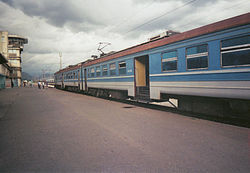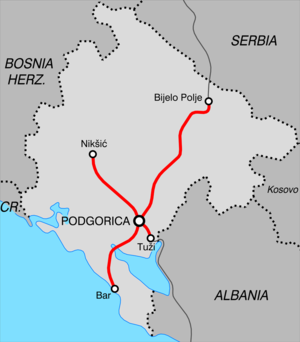- Railways of Montenegro
-
Railways of Montenegro 
EMU train at the Podgorica Rail Station Operation National railway Жељезница Црне Горе / Željeznica Crne Gore (ŽCG) Statistics System length Total 250 km (155 mi) Electrified 162 km (101 mi) Gauge Main 1,435 mm (4 ft 8 1⁄2 in) (standard gauge) Electrification Features No. tunnels 121 Tunnel length 58 km (36 mi) No. bridges 120 Map Rail transport in Montenegro is operated by three separate companies, which independently handle railway infrastructure, passenger transport and cargo transport.
Montenegro is a member of the International Union of Railways (UIC). The UIC Country Code for Montenegro is 62.
Contents
History
First railway in the territory that today belongs to Montenegro was narrow gauge (760 mm) Gabela - Zelenika line in 1901. This railway was built by Austria-Hungary, as it governed the territory of Boka Kotorska at the time.
However, the works on first Montenegrin railway, the Bar - Virpazar line, begun in 1905. This 750mm gauge, 43,3 km long railway was opened in 1908. The extension of this line from Virpazar to Cetinje was planned, but never came through, due to the lack of funding, and the beginning of the First World War. This historic mountain railway line overcame a rise of 550m over a 22 km run on the Sutorman mountain, with a maximum grade of 40‰. Despite the steep gradient, the railway was not using rack technology, due to the innovative route design by Italian engineers. The operating speeds on the line were 18 km/h for passenger transport, and 12 km/h for freight movement. In 2008, on the 100th anniversary of the line opening, and at the same time the anniversary of Montenegrin railways as a whole, it was planned to transfer the steam locomotive Lovćen from Podgorica Rail Station to Virpazar. This locomotive, which operated on the line, should become a part of a Montenegrin railway museum in Virpazar, which, due to lack of funds, never came through.[1]
The railway network in Montenegro expanded during the period of Kingdom of Yugoslavia. In 1927, the Podgorica - Plavnica line (600 mm) was opened, followed by Bileća - Nikšić line in 1938. At that time, the railway network of Montenegro measured 143 km in length, with 760 mm narrow gauge as a most common standard. However, the railway network was not integrated, and 600 mm, 750 mm and 760 mm were present, additionally complicating the network operations. Multimodal transport was used for freight transport between Bar and Podgorica, as goods were transported by rail from Bar to Virpazar, then ferried across the Skadar Lake to Plavnica, followed by rail transport to Podgorica once again. Thus, it is fair to say that railway network in Montenegro was underdeveloped and unorganized prior to World War II.
Following the World War 2, the railway line Podgorica - Nikšić was completed (1947), with 760 mm gauge. The first real advance towards modernisation of railway network was the start of construction of the Montenegrin section of Belgrade-Bar railway. The first section from Bar to Podgorica was completed in 1959, and this is the first section of standard gauge railway in Montenegro. At the same time, narrow gauge Podgorica - Plavnica and Bar - Virpazar lines were decommissioned.
In 1965, the Podgorica - Nikšić corridor was upgraded to standard gauge, thus standardizing the entire connection from Bar to Nikšić via Podgorica. The section from Nikšić to Bileća was decommissioned at the time, as well as the Gabela - Zelenika line. The Montenegrin section of colossal Belgrade-Bar railway project (from Bar to Vrbnica, border with Serbia) was completed in 1976, connecting Bar and Podgorica with the northern Montenegro, Serbia, and European rail network. At that time, the length of Montenegrin railway network was 215 km, with transition to standard gauge complete.
The latest addition to the Motenegrin railways was Podgorica–Shkodër line, which opened in 1986. This was a freight-only line since its opening.
Organization
Rail transport in Montenegro is operated by three separate companies, which independently handle railway infrastructure, passenger transport and cargo transport. The three companies were a part of public company Railways of Montenegro (Montenegrin: Жељезница Црне Горе / Željeznica Crne Gore (ŽCG)) until it was split up in 2008.
Railway Infrastructure of Montenegro
Railway infrastructure of Montenegro
Željeznička infrastruktura Crne Gore
Жељезничка Инфраструктура Црне ГореType Government-owned Industry Rail Transport Founded 2008 Headquarters Podgorica, Montenegro Services Rail Transport Website http://www.zicg.me/ Railway Infrastructure of Montenegro (Montenegrin: Жељезничка Инфраструктура Црне Горе / Željeznička Infrastruktura Crne Gore (ŽICG)) is a company that handles operation, oversight, maintenance, and modernization of the Montenegrin railway network.
The total network is 250 kilometres long and is 1,435 mm (4 ft 8 1⁄2 in) (standard gauge) for its entire length, with 162 of them electrified at 25 kV 50 Hz AC. Almost 58 km of lines are situated in 121 tunnels. There are also 120 bridges, 9 galleries and 440 culverts. The network consists of three railway lines, meeting at Podgorica, with two lines having their terminus at Podgorica.[2]
- Belgrade-Bar railway is the backbone of the Montenegrin railway system. It opened in 1979, and then was a state-of-the art railway, with features such as Mala Rijeka viaduct (highest railway viaduct in the world) and the 6.2 km long Sozina tunnel. About one-third of the Montenegrin part of the railway is in a tunnel or on a viaduct. It is the only railway corridor in Montenegro that is fully electrified: electrification of Podgorica - Nikšić corridor is not complete. The railway has suffered from chronic underfunding in 1990s, resulting in it deteriorating and becoming unsafe. This culminated in the 2006 Bioče train disaster, when a passenger train derailed, killing 47 passengers. Efforts are being made to thoroughly reconstruct this railway.
- The Nikšić-Podgorica railway (56,6 km long) was built in 1948 as narrow gauge railway, and upgraded to normal gauge in 1965. Since 1992, it has been used solely for freight traffic, particularly bauxite from the Nikšić mine to the Podgorica Aluminium Plant, with maximum speed on the railway reduced to 30 km/h. That is about to change, as this part of railway is currently under complete reconstruction and electrification. Passenger traffic is set to start in 2009, and maximum speeds will be between 75 and 100 km/h.
- The Podgorica-Shkodër railway, which extends to Tirana, has been used exclusively for freight traffic since its opening. Parts in Albania were damaged in 1997, but the connection was restored in 2002. There are plans to reconstruct the railway and re-introduce passenger traffic, as it is important for interests of both Montenegro and Albania.
Rail links with adjacent countries
Montenegro only has railway links with Serbia. The link with Albania is only in use for freight. There are currently no railway connections with Bosnia and Herzegovina and Kosovo.
- Same gauge:
 Albania — freight only
Albania — freight only Bosnia and Herzegovina — currently no railway connections
Bosnia and Herzegovina — currently no railway connections Croatia — currently no railway connections
Croatia — currently no railway connections Serbia — passenger and freight
Serbia — passenger and freight Kosovo — currently no railway connections
Kosovo — currently no railway connections
Railway transport of Montenegro
Railway transport of Montenegro
Željeznički prevoz Crne Gore
Жељезнички превоз Црне Горе
Type Government-owned Industry Rail Transport Founded 2008 Headquarters Podgorica, Montenegro Services Rail Transport, Services Website http://www.zcg-prevoz.me/ Railway transport of Montenegro (Montenegrin: Жељезнички превоз Црне Горе / Željeznički prevoz Crne Gore (ŽPCG)) is a company that handles passenger transport within Montenegro, as well as operation, maintenance, and modernization of the Montenegrin rolling stock.
Rolling stock
Rolling stock of Railway transport of Montenego consists of 39 locomotives and 4 EMUs:
- 16 locomotives of class 461 (4 are awaiting the general overhaul)
- 4 electric multiple unit sets of class 412/416
- 7 locomotives of class 661 (2 active, 2 are awaiting the general overhaul)
- 4 locomotives of class 644
- 4 locomotives of class 642 (2 active)
- 2 locomotives of class 643
- 6 locomotives of class 744 (none of them is active)
There are also:
- Passenger cars:
- 31 passenger coaches (classes A, AB and B)
- 1 buffet car (class WR)
- 32 sleeping and couchette cars (classes AcBc, Ac, Bc and WLAB)
- 10 car-carrier wagons (class DDam)
- Freight cars:
- 226 wagons (class G)
- 15 wagons (class K)
- 62 wagons (class R)
- 7 wagons (class S)
- 415 wagons (class E)
- 29 wagons (class F)
- 34 wagons (class Z)
- 33 wagons (class U)
- 3 wagons (class H)
Montecargo
Montecargo
MontecargoType Government-owned Industry Freight rail transport Founded 2008 Headquarters Podgorica, Montenegro Services Freight rail transport Revenue 10 million EUR (2010) Net income 1,5 million EUR (2010) Employees 209 Website http://www.montecargo.me/ Montecargo (Montenegrin: Montecargo) is a company that handles freight transport within Montenegro, as well as operation, maintenance, and modernization of the Montenegrin goods wagons and locomotives.
Rolling stock of Montecargo consists of 17 locomotives (15 active) and 713 freight wagons:
- 8 locomotives of class 461
- 3 locomotives of class 661
- 4 locomotives of class 644
- 2 locomotives of class 744 (none of them is active)
Railways of Montenegro in fiction
James Bond travels on Railways of Montenegro in Casino Royale. The actual train seen in the movie is the Pendolino tilting train of Czech Railways.
See also
References
- ^ ""Lovćen" se vraća kući". Pobjeda. 2008-01-06. http://www.pobjeda.co.me/citanje.php?datum=2008-06-01&id=142257. Retrieved 2011-01-19.
- ^ ŽICG Network Statement 2010PDF
External links
- Željeznička infrastruktura Crne Gore (in Montenegrin)
- Željeznički prevoz Crne Gore (in Montenegrin)
- Montecargo (in Montenegrin)
- Map of the railway network
National railway companies of Europe  HSH •
HSH •  HYU1 •
HYU1 •  ÖBB •
ÖBB •  ADY1 •
ADY1 •  BŽD/BČ •
BŽD/BČ •  SNCB/NMBS •
SNCB/NMBS •  ŽFBH2 and ŽRS3 •
ŽFBH2 and ŽRS3 •  BDŽ •
BDŽ •  HŽ •
HŽ •  ČD •
ČD •  DSB •
DSB •
 EVR •
EVR •  VR •
VR •  SNCF •
SNCF •  SR1 •
SR1 •  DB •
DB •  TrainOSE •
TrainOSE •  MÁV •
MÁV •  IÉ •
IÉ •  FS •
FS •  KTŽ1 •
KTŽ1 •  HK/KŽ4 •
HK/KŽ4 •  LDZ •
LDZ •  LG •
LG •
 CFL •
CFL •  MŽ •
MŽ •  CFM •
CFM •  ŽCG •
ŽCG •  NS •
NS •  NSB •
NSB •  PKP •
PKP •  CP •
CP •  CFR •
CFR •  RŽD •
RŽD •  ŽS •
ŽS •  ŽSR •
ŽSR •  SŽ •
SŽ •
 RENFE •
RENFE •  SJAB •
SJAB •  SBB/CFF/FFS •
SBB/CFF/FFS •  TCDD1 •
TCDD1 •  UZ •
UZ •  BR5 / NR6 / NIR71Country partly in Asia • 2For the Federation BH • 3For Srpska • 4State with limited recognition • 51948-2000
BR5 / NR6 / NIR71Country partly in Asia • 2For the Federation BH • 3For Srpska • 4State with limited recognition • 51948-2000
6Created in 1999, owned by ATOC • 7For Northern IrelandRail transport in Europe Sovereign
states- Albania
- Andorra
- Armenia
- Austria
- Azerbaijan
- Belarus
- Belgium
- Bosnia and Herzegovina
- Bulgaria
- Croatia
- Cyprus
- Czech Republic
- Denmark
- Estonia
- Finland
- France
- Georgia
- Germany
- Greece
- Hungary
- Iceland
- Ireland
- Italy
- Kazakhstan
- Latvia
- Liechtenstein
- Lithuania
- Luxembourg
- Macedonia
- Malta
- Moldova
- Monaco
- Montenegro
- Netherlands
- Norway
- Poland
- Portugal
- Romania
- Russia
- San Marino
- Serbia
- Slovakia
- Slovenia
- Spain
- Sweden
- Switzerland
- Turkey
- Ukraine
- United Kingdom
- Vatican City
States with limited
recognition- Abkhazia
- Kosovo
- Nagorno-Karabakh
- Northern Cyprus
- South Ossetia
- Transnistria
Dependencies
and other territories- Åland
- Faroe Islands
- Gibraltar
- Guernsey
- Jan Mayen
- Jersey
- Isle of Man
- Svalbard
Other entities Categories:- Rail transport in Montenegro
Wikimedia Foundation. 2010.

